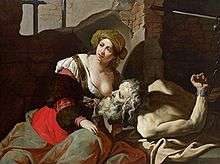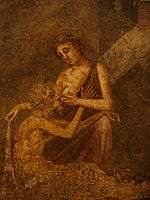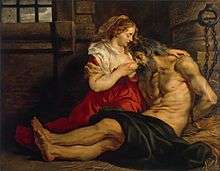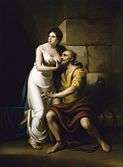Roman Charity

Roman Charity (Latin Caritas romana; Italian Carità Romana) is the exemplary story of a woman, Pero, who secretly breastfeeds her father, Cimon, after he is incarcerated and sentenced to death by starvation. She is found out by a jailer, but her act of selflessness impresses officials and wins her father's release.[1]
History
The story is recorded in Factorum ac dictorum memorabilium (Nine Books of Memorable Acts and Sayings of the Ancient Romans)[2] by the ancient Roman historian Valerius Maximus, and was presented as a great act of pietas (i.e., filial piety) and Roman honour. A painting in the Temple of Pietas depicted the scene.[3] Among Romans, the theme had mythological echoes in Juno's breastfeeding of the adult Hercules, an Etruscan myth.[4]
The story of Cimon is predated, however, by an almost identical story recorded by Roman historian Valerius Maximus, later retold by Pliny the Elder (23-79), of a jailed plebeian woman who was nursed by her daughter.[5] Historians note that Renaissance and Baroque depictions have more incestuous overtones.[5]
In the seventeenth and eighteenth centuries, many European artists depicted the scene.[6] Most outstandingly, Peter Paul Rubens painted several versions. Baroque artist Caravaggio also featured the deed (among others) in his work from 1606, The Seven Works of Mercy. Neoclassical depictions tended to be more subdued.[7]
In the 20th century a fictional account of Roman Charity was presented in John Steinbeck's The Grapes of Wrath (1939).[8] At the end of the novel, Rosasharn (Rose of Sharon) nurses a sick and starving man in the corner of a barn. The 1969 painting Partisan Ballad by Mai Dantsig also echoes Roman Charity.[9]
The 1973 surrealist film O Lucky Man! also contains a scene of Roman Charity when the protagonist is starving and a vicar's wife nurses him rather than let him plunder the food gathered for an offering.[10]
Artists' depictions

 "Roman Charity"
"Roman Charity"
Artist unknown.
(c. 1500-1520)





 "Cimon and Pero"
"Cimon and Pero"
By Christoph Maucher
(amber, 1690)


 "La caridad romana"
"La caridad romana"
By Luis Monroy
(1873) "Roman Charity"
"Roman Charity"
Baroque painting of Italian School
(17th century)
Notes and references
- ↑ "Iconographical sources of nursing and nursing gestures in Christian cultures," Darkfiber.com, last visited 29 March 2006
- ↑ Book V, 5.4.7
- ↑ Mary Beagon, The Elder Pliny on the Human Animal: Natural History Book 7 (Oxford University Press, 2005), p. 314 online.
- ↑ Nancy Thomson de Grummond, Etruscan Myth, Sacred History, and Legend (University of Pennsylvania Museum of Archaeology and Anthropology, 2006), pp. 83–84.
- 1 2 Yalom, Marilyn (April 10, 2013). "Roman Charity", The New York Times. Retrieved November 5, 2014.
- ↑ J. Paul Getty Museum. Cimon and Pero: "Roman Charity." Jean-Baptiste Greuze., last visited 23 September 2008
- ↑ Shearer West, "Guide To Art." Bloomsbury, 1996 Bloomsbury.com, accessed 29 March 2006
- ↑ Steinbeck, John. The Grapes Of Wrath. New York: Viking Press, 1939.
- ↑ "Partisan ballade 1969". Art Russe. Retrieved 10 Dec 2015.
- ↑ http://www.imdb.com/title/tt0070464/synopsis?ref_=tt_stry_pl
External links
 Media related to Roman Charity at Wikimedia Commons
Media related to Roman Charity at Wikimedia Commons- Nine Books of Memorable Acts and Sayings of the Ancient Romans, in Latin
- "The Female Breast as a Source of Charity: Artistic Depictions of Caritas Romana", an essay by Golda Balass, a lecturer in the Department of Art History at Tel Aviv University
- Stargate Libraries Gallery